ECOMMERCE: SUSTAINABLE DELIVERY
Top 5 Trends in Sustainable Delivery: Green Packaging, Eco-Friendly Logistics
Sustainability is more than a buzzword. Retail giants are strategizing to achieve net-zero carbon emissions, while online consumers are gaining awareness about eco-friendly shopping. Here are the five key trends driving sustainability in eCommerce delivery.
Article by Nashra Fatima | September 17, 2024
Trends in Sustainable Delivery: Key Insights
Consumer Perspective: Across the world, consumers are increasingly aware of sustainability in shipping, with many interested in carbon-neutral delivery, eco-friendly packaging, and slower deliveries.
Green packaging: Consumers in diverse world markets now consider recyclable packaging important. Over half the survey respondents in India, Brazil, China value it, with the share only slightly smaller in Germany, France, and the U.S.
Modern delivery: More than half the consumers in North America and Europe expect home delivery through electric vehicles in the next two years. Autonomous drone delivery is also a growing trend, with the market value of cargo drones projected to cross US$17 billion by 2030.
Automation: Route optimization is found to contribute notably to the reduction of logistics carbon emission by 2030. Warehouse automation is also an expanding market, with hundreds of companies working to provide mobile robots, automated storage, and software solutions.
eCommerce is proving to be quite democratic. Online retail revenues in China and the U.S. have crossed other countries’ annual GDPs. Moreover, developing nations across Asia and Latin America are emerging markets, with data predicting their remarkable eCommerce growth.
But there is a catch: as eCommerce grows, so does its environmental impact.
Sustainability discussions are gaining traction in eCommerce worldwide, with delivery a critical touchpoint where the need for eco-friendly solutions is high. We explain what sustainable delivery means, consumers’ views about it, and the top five trends in sustainable eCommerce shipping.
Sustainable Delivery: What Does It Mean?
eCommerce growth has accelerated the need for delivery services. Although convenient for consumers, it is harmful for the environment. The sustainability turn in eCommerce emphasizes that deliveries should not just be fast and precise but also socially responsible.
Sustainable delivery is a part of modern logistics. It refers to practices that reduce the carbon footprint of eCommerce. Also called green shipping, it covers multiple aspects—from packaging to transport to warehousing to last-mile delivery.
Calls to incorporate sustainability measures in eCommerce are becoming louder, with companies and consumers both showing greater interest in ethical production and consumption.
Sustainable Shipping: What Do
Consumers Want?
A 2023 survey by Descartes shows that consumer interest in sustainable delivery is wide-ranging:
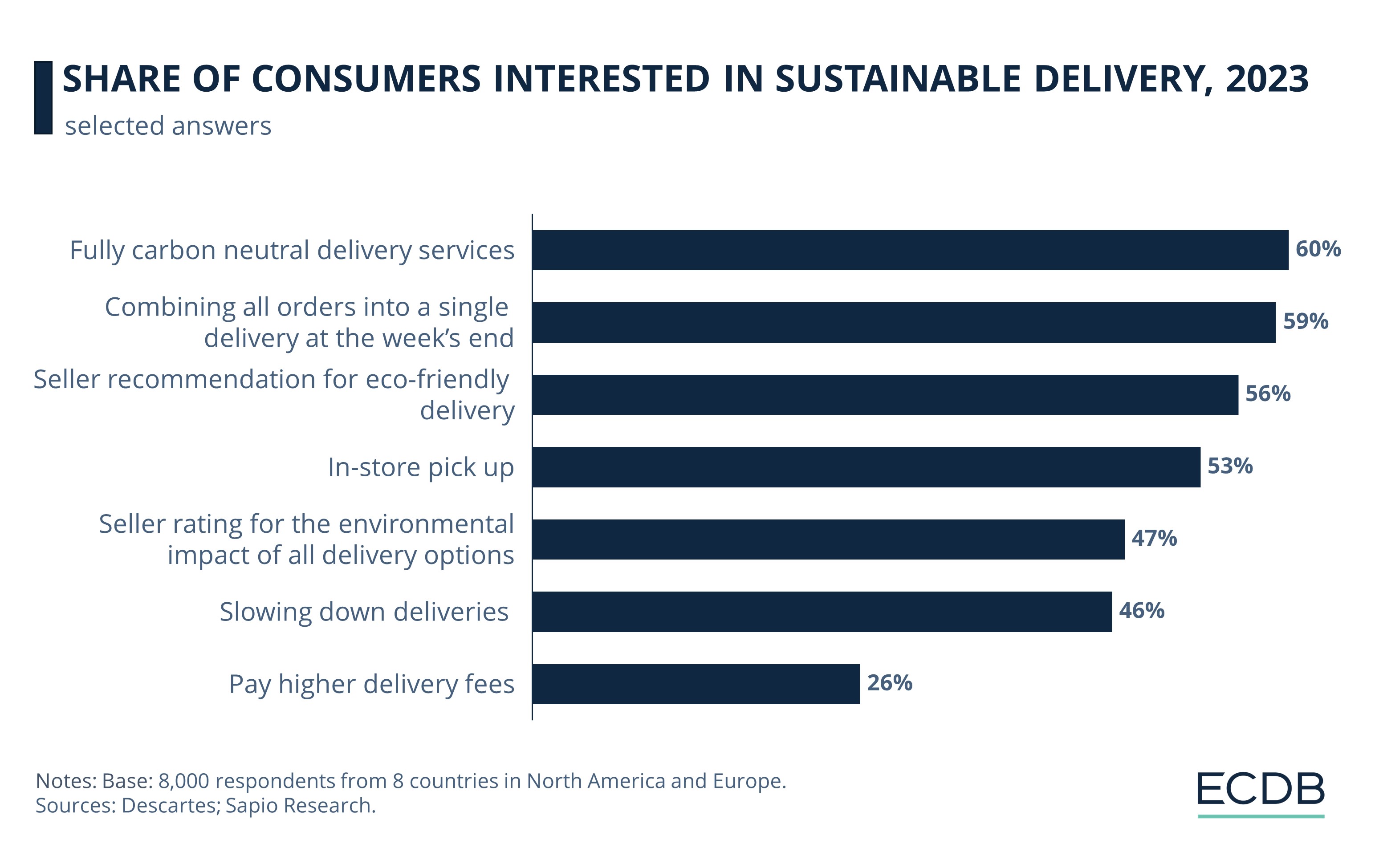
60% of consumers are interested in fully carbon neutral delivery services. This means offsetting carbon emissions through eco-friendly measures like using recyclable materials and electric delivery vehicles.
59% approve of combining multiple orders into a single delivery, which reduces packaging and the number of drop-offs.
56% wish to see seller recommendations for eco-friendly options, while 47% want seller ratings for the environmental impact of all delivery methods, so they may make an informed decision.
Over half the consumers (53%) do not mind in-store pick up of their orders. This reduces the impact of last mile delivery.
46% of respondents would not mind slower shipping, which is more sustainable than ultra-fast or same-day delivery.
Over a quarter of respondents (26%) are willing to pay higher delivery fees if it is more sustainable.
The survey underscores that consumers are aware of and interested in sustainable delivery. They may even be willing to adjust their expectations around fast shipping and returns—demands that are critical but which leave a significant mark on the environment.
So, which measures are being taken at present to make delivery sustainable?
Top 5 Trends in Sustainable eCommerce Delivery
The top five trends driving sustainability in eCommerce delivery in 2024 cover several aspects, including: recyclable packaging, eco-friendly and autonomous delivery, smart route planning, and automated warehousing.
1. Sustainable Packaging
There is growing awareness about plastic use and the environmental havoc it wreaks. This drives the trend of recyclable packaging, for which there is also a notable consumer demand.
According to Statista Consumer Insights of 2023, consumers in diverse markets consider eco-friendly – that is, recyclable, non-plastic, or minimal – packaging important:
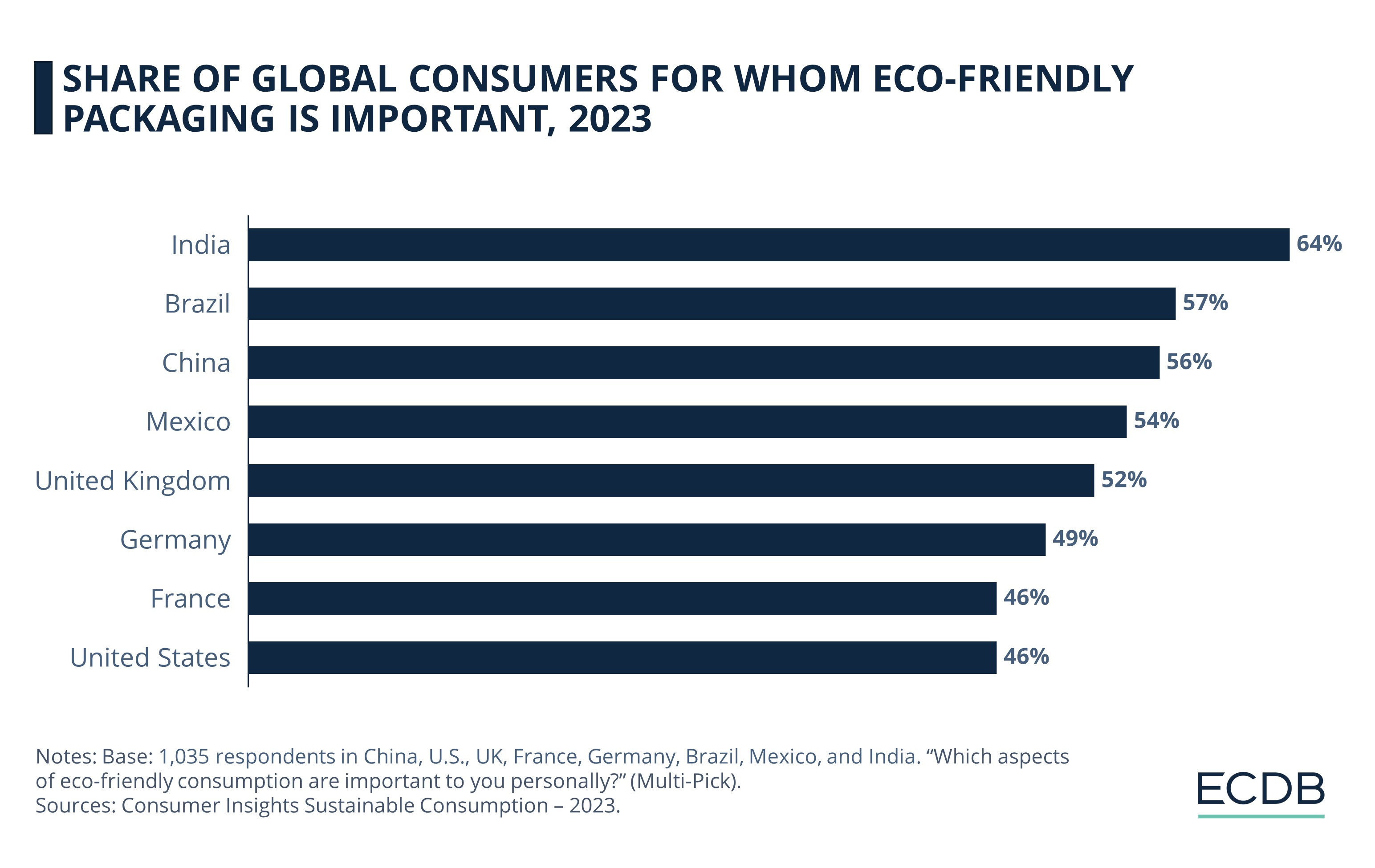
In India, the highest share of consumers - 64% - value eco-friendly packaging.
In Brazil, China, Mexico, and the United Kingdom, the share of consumers who want recyclable packaging is not far behind, ranging between 52-57%.
In Germany, France, and the United States, the share is smaller but still considerable, between 46-49%.
Companies are minimizing packaging, using recyclable materials, limiting plastic use, and consolidating packages to reduce waste. For example, earlier this year, Walmart began phasing out its single-use plastic envelopes for online orders. They are being replaced by reusable paper.
2. Electric Delivery Vans
The use of electric vehicles (EVs), which includes vans and bikes, is picking up pace. More environmentally friendly than traditional gas-powered vans, EVs have lower operational costs, fuel demands, and no tail pipe emissions.
According to a survey conducted in eight North American and European countries, in 2023, consumers have become more aware of electric vehicle usage for last-mile delivery. The share of customers expecting home delivery through EVs rose significantly in a period of just one year.
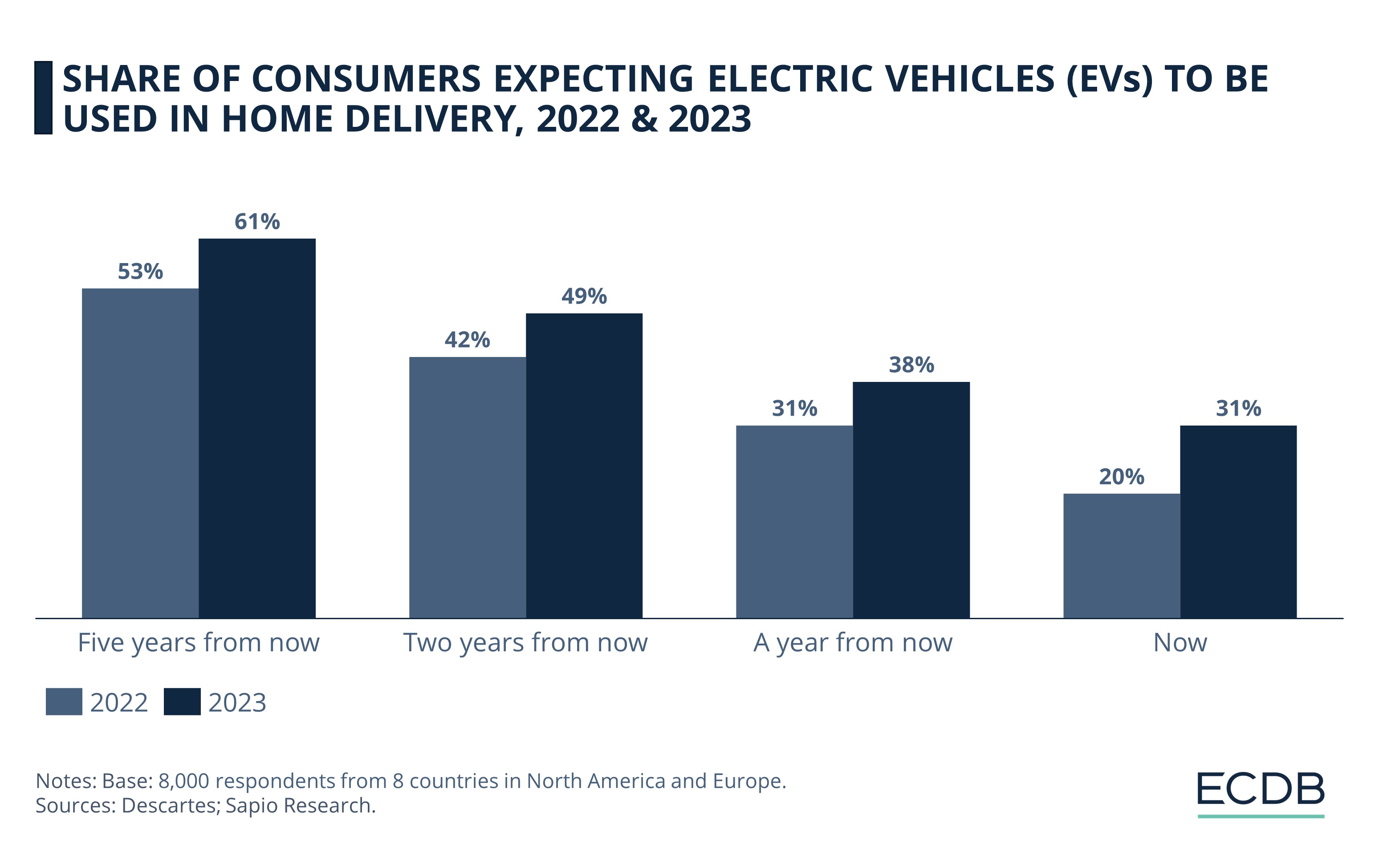
In 2023, 61% of consumers anticipate receiving home deliveries through EVs in the next five years, compared to 53% who expected the same in 2022.
Half the respondents (49%) in 2023 want to see delivery via electric vehicles in the next two years, and 38% expect to see it in a year.
31% of online consumers in 2023 believe electric fleets should be used now—an increase of 11 percentage points from 2022, when only 20% expected it.
Well-known eCommerce retailers are leveraging electric vehicles, with Amazon leading the decarbonization of its delivery fleet. It has over 15,000 electric vehicles on the street across the United States, and 300 in Germany. It plans to increase the total to 100,000 EVs by 2030.
3. AI Delivery Drones
Artificial Intelligence (AI) has multiple applications in eCommerce shipping. It can be used to optimize truck loads and predict outcomes, like the success rate of deliveries, the number of delivery attempts, and rate of returns.
But perhaps nowhere is its use more spectacular than in AI-operated drones for delivery. This autonomous delivery type is fast, efficient, and environmentally friendly. Drones do not require fossil fuels to run, which means less carbon emissions.
Cargo drones are used in eCommerce, as well as for other purposes like rescue surveillance, disaster response, and crop spraying. Data shows that the cargo drone market is increasing in value.
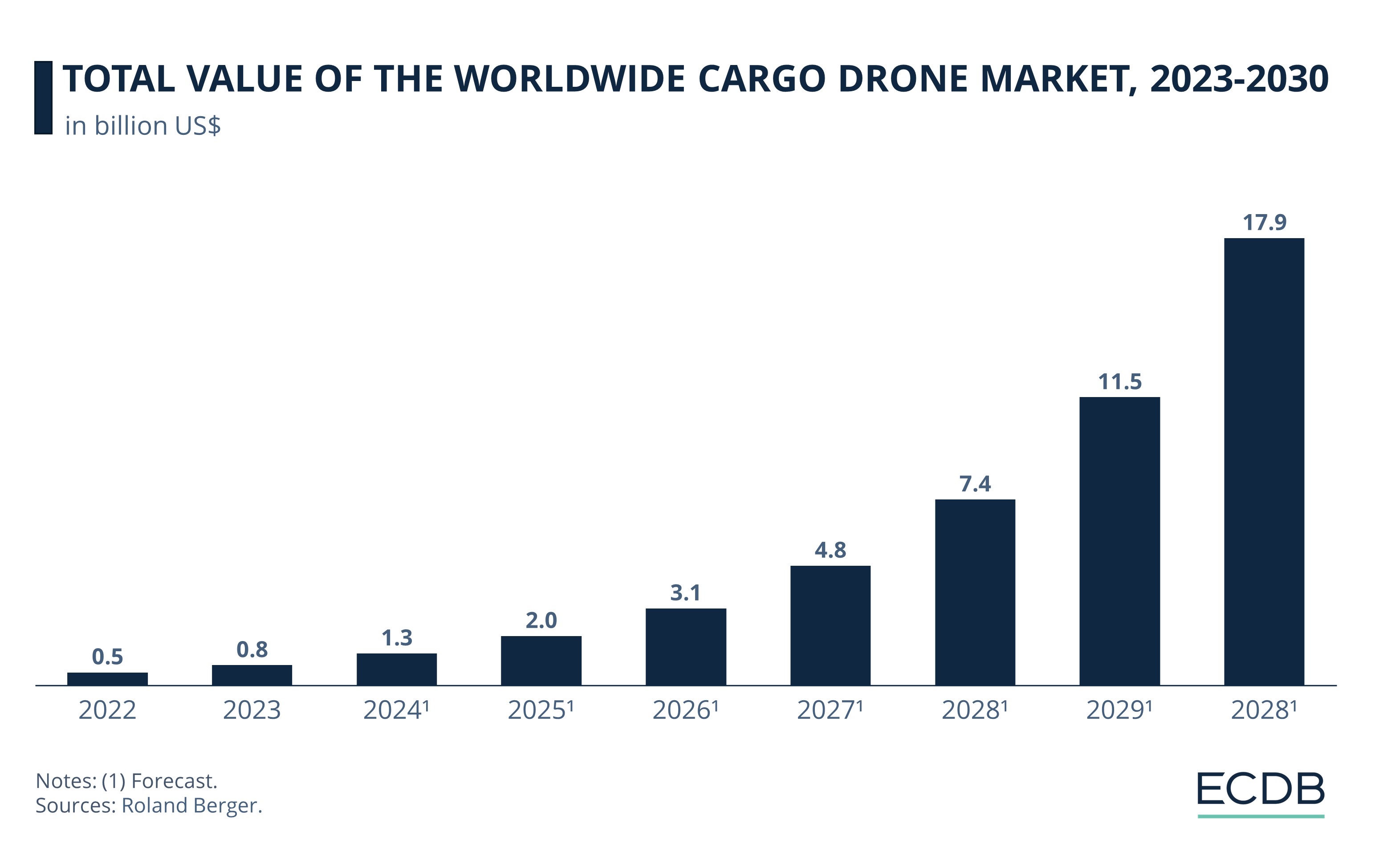
In 2023, the cargo drone market was valued at US$800 million. This year, it will cross the US$1 billion mark.
Predictions are that the largest expansion will occur between 2027 and 2029, when the market will grow by 140% – from US$4.8 billion to US$11.5 billion.
The market value is forecast to reach an impressive US$17.9 billion by 2030.
Logistics giant UPS is operating a drone delivery fleet. Last year, it gained permission in the United States to operate its drones beyond the visual line of sight of pilots. This means they can now deliver over much longer distances, with minimal human intervention, and scale their operations.
4. Green Route Planning
This refers to eco-friendly route planning and is part of green logistics. Optimizing delivery routes involves using smart technologies like AI, GPS, and the Internet of Things (IoT) to:
Avoid traffic, take fuel-efficient routes, and reduce miles travelled
Change routes based on real-time information about conditions such as weather
Multi-stop route planning to fulfil several orders in one go
According to McKinsey, existing technologies, including route optimization, have the potential to cut down logistics carbon emissions by 40-50% by 2030:
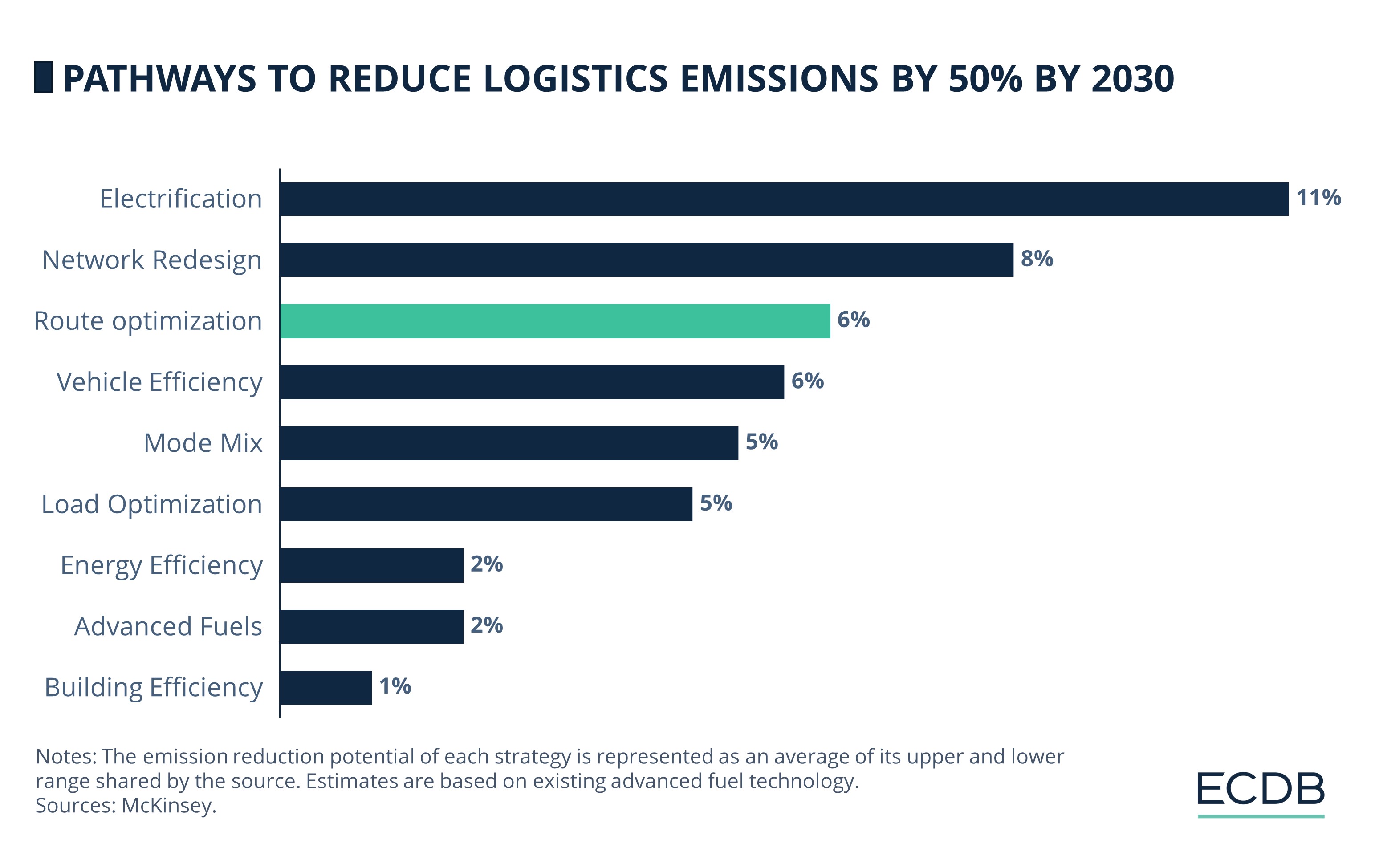
Route optimization can help decrease logistics emissions by an average of 6% by 2030.
More effective strategies for emission reduction are electrification (11%) and network redesign (8%)
Other useful measures include vehicle efficiency (6%), load optimization (5%) and energy efficiency (2%).
Route optimization not only helps decarbonize logistics, but it also reduces time, errors, and money spent on deliveries. A good example is Walmart’s AI-powered Route Optimization tool. It maps routes automatically, optimizes trailer loading, intelligently plans return trips, and minimizes the impact of disruptions on delivery.
5. Warehouse Automation
Warehouse automation involves automating the movement of goods into, within, and out of warehouses. Considering the central role that warehouses play in eCommerce, making them more sustainable and efficient has a ripple impact on supply chain processes. Examples are:
Using driverless vehicles or robots to pick, pack, sort, and move goods
Using monitoring systems and sensors to track goods, measure and automatically adjust humidity and temperature
Such measures consume less energy, reduce waste, and lower operational costs. Data shows the number of companies active in various sectors of warehouse automation:
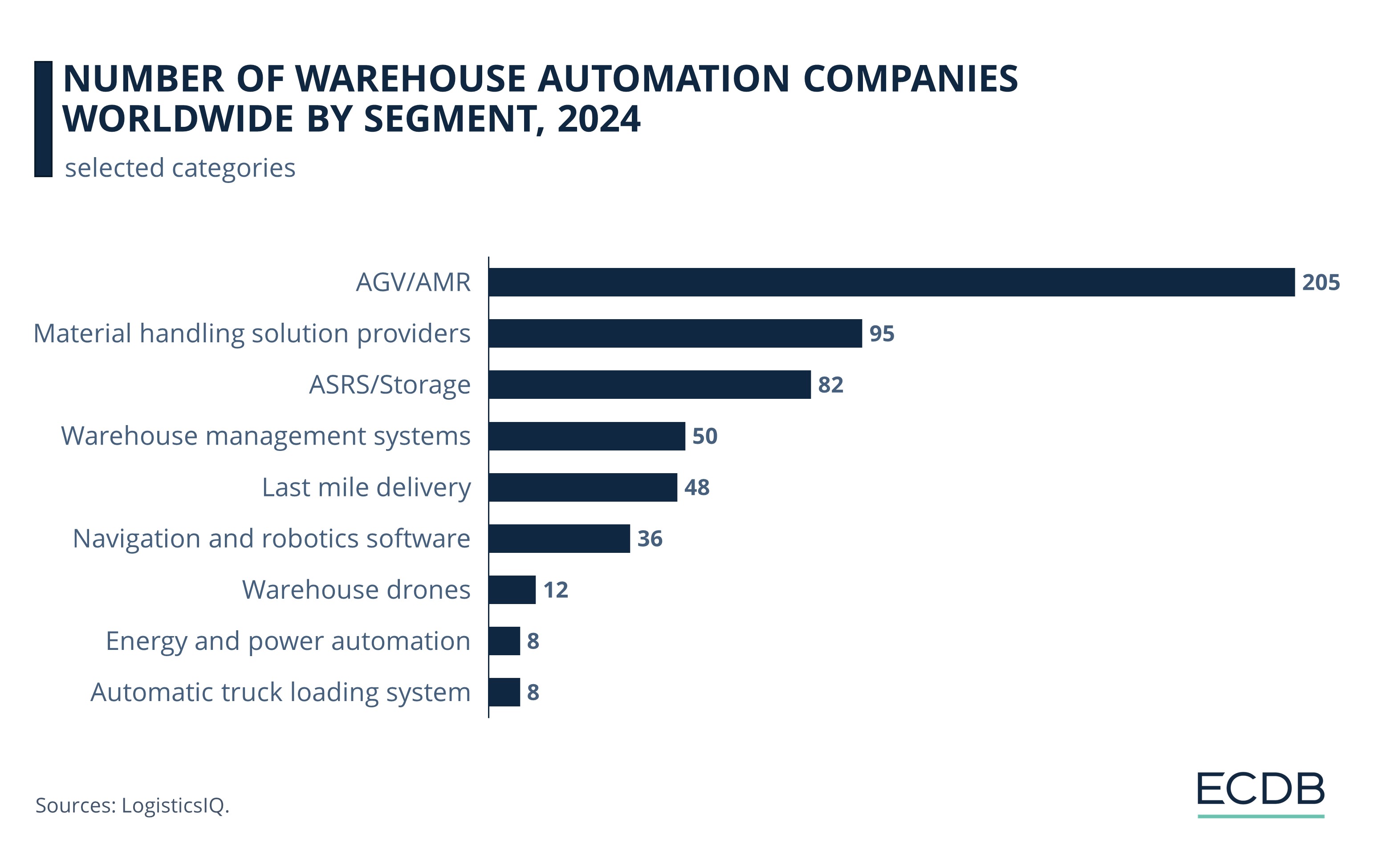
205 companies are working in AGV (Automated Guided Vehicles) and AMR (Automated Mobile Robots), attesting to its growing usage
95 to 82 companies respectively are working as material handling solution providers and in ASRS (Automated Storage and Retrieval System)
50 companies offer warehouse management systems, which means software for warehouse automation.
48 are working in the sector of last mile delivery automation – a key step in logistics sustainability.
Other emerging sectors are navigation and robotics software, warehouse drones, and automatic truck loading systems, with the number of companies working in these fields ranging from 8 to 36.
Chinese eCommerce giant Alibaba is working to make its warehouses smart and digital. In addition to using AMRs and AGVs, it aims to use IoT to monitor goods and control aspects like humidity and temperature. This is particularly helpful for storing perishable goods and sensitive equipment. Amazon is also using robots named Robin, Proteus, and Sequoia to advance automation in its warehouses.
Valuable Insights: Our data-driven rankings are regularly refreshed to provide you with crucial insights for your business. Find out which stores and companies are performing will in the eCommerce space and which categories are topping the sales charts. Stay ahead of the market with our rankings for companies, stores, and marketplaces.
Sustainable Delivery in eCommerce: Closing Remarks
Sustainable delivery is critical for companies aiming to offset their carbon footprint and become more socially responsible. Data also confirms that consumers are interested in receiving their parcels through environmentally friendly means.
The rise in awareness on both sides is accelerating sustainable delivery trends like green packaging, autonomous and electric transportation, and green warehousing. Influential retail companies like Walmart, Amazon, and Alibaba, among others, have launched initiatives to make their supply-chain systems eco-friendly and efficient.
But there is more ground to cover. Our ECDB insight found that consumers in large markets like China and the U.S. do not yet prioritize sustainable deliveries. So, companies must not only focus on decarbonization policies and green strategies, but also on engaging with customers, as studies indicate that information can shift consumer preferences towards more sustainable delivery choices.
Sources: Walmart: 1, 2; Amazon: 1, 2; Popular Science; Alibaba; Techwire Asia; ECDB; Science Direct.

Click here for
more relevant insights from
our partner Mastercard.
Related insights
Deep Dive
Gen Z Online Shopping Behavior: Consumer Habits, Preferences & Trends
Gen Z Online Shopping Behavior: Consumer Habits, Preferences & Trends
Deep Dive
Guess Joins an Affiliation with SuperCircle for Clothing Recycling Program
Guess Joins an Affiliation with SuperCircle for Clothing Recycling Program
Deep Dive
Trends in German eCommerce: Germans Like What They Know
Trends in German eCommerce: Germans Like What They Know
Deep Dive
Almost Two-Thirds of German Consumers Favor Drone Delivery of Packages
Almost Two-Thirds of German Consumers Favor Drone Delivery of Packages
Deep Dive
Global Consumer Attitudes Towards Sustainable eCommerce: Delivery, Packaging, Country Preferences
Global Consumer Attitudes Towards Sustainable eCommerce: Delivery, Packaging, Country Preferences
Back to main topics